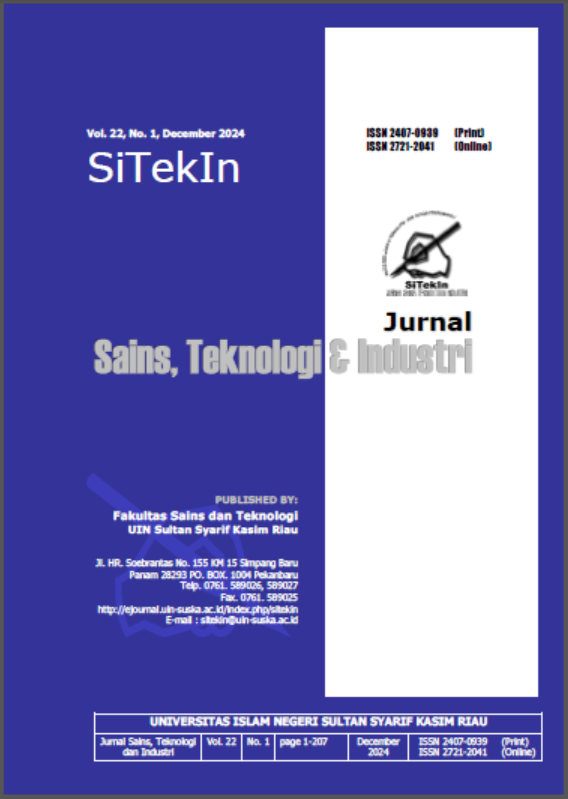Design And Building of A Temperature and Humidity Control System For an Oyster Mushroom Cultivation Room Based on Arduino Mega
DOI:
https://doi.org/10.24014/sitekin.v22i1.33473Abstract
Mushrooms are a type of exotic vegetable commodity that has quite high economic value and has great potential for cultivation. Oyster mushrooms are a type of mushroom that is much loved by Indonesian people and are a food source that is popular with people and contains quite high nutrition. The factors that determine mushrooms to grow well are temperature, humidity, CO2 levels and light intensity. This research aims to increase the efficiency of oyster mushroom cultivation by utilizing Arduino Mega technology in the oyster mushroom cultivation room and using a DHT-11 temperature sensor as a temperature and humidity detector in the oyster mushroom cultivation room. cultivation room. The parameters used to test the quality of the DHT-11 sensor are accuracy and normality test. The DHT-11 temperature sensor data is processed on the Arduino Mega and then displayed via LCD in real time. The system test results obtained in this research show that the system can work to control well with temperature values between 26-29°C with humidity 70-90%. From the results of the system test, the mushrooms will grow well.
References
Susilawati,Budi Raharjo,” Environmentally friendly cultivation of oyster mushrooms (Pleourotus astreatus var florida).”bptp,2018.
Pradina Giashinta” Device for controlling temperature and humidity and monitoring the harvest period for cultivating oyster mushrooms based on Arduino Uno" Faculty of Engineering, Yogyakarta State University,2018.
Widiwurjani, Guniarti, “Potential of oyster mushroom seeds cultured from agro-industrial media” National Development University, 2016
Gyorfi, J., Hadju, C.S, “Casing-Material Experiments With P.Eryngii.Int. J. Horticult. Sci. 13, 33 36, 2007.
Suharjo, Enjo. “Budidaya jamur tirammedia kardus” Agromedia Pustaka, 2015.
Saptadi, A. H., “"Comparison of temperature and humidity measurement accuracy between DHT11 and DHT22 sensors" Electronic Telecommunications Informatics Journal, 6(2), 49. 2014.
Wijaya, I. K., “Use and selection of mini circuit breaker safety" Udayana University, 2007.
Rahman, R.A., Muskhir, M, “"Monitoring the temperature and humidity control of oyster mushroom mushrooms" Indonesian Electrical Engineering journal,2(2), 226-272, 2021.
Darmawan, B., Astutik, F, “Design and manufacture of pasteurization temperature control equipment for oyster mushroom growing media based on the ATMEGA16 microcontroller” Proceedings of the national seminar on Electrical Engineering, pp C49-C53, 2014.
Saputra, C., Setiawan, R., Arvita, Y. “"Implementation of a Temperature and Monitoring and Humidity Control System in IOT-Based Oyster Mushroom Mushrooms Using the Fuzzy Logic Method" Journal of Science and Informatics, 8(2), pp. 116-126, 2022.
Basic Electronics, (2023). InfraRed (IR) Detektor (Infrared). Accessed August 13, 2023, https://elektronika-dasar.web.id/infra-red-ir-detektor-sensor-infra-merah/
Putra. (2015). Explanation and schematic of the Power Supply circuit. Accessed March 03, 2023, https://putra1998.blogspot.com/2015/02/penjelasan-dan-skema-rangkaian-power.html
Rahman, R.A., Muskhir, M. (2021) „ Monitoring Temperature and Humidity Control of Oyster Mushroom Kumbung', Indonesian Electrical Engineering Journal, 2(2), pp. 226-272.
Saptadi, A. H. (2014). Comparison of Temperature and Humidity Measurement Accuracy Between DHT11 and DHT22 Sensors. INFOTEL JOURNAL - Electronic Telecommunications Informatics, 6(2), 49. https://doi.org/10.20895/infotel.v6i2.16
Downloads
Published
Issue
Section
License
This work is licensed under a Creative Commons Attribution-ShareAlike 4.0 International License
Copyright Notice
An author who publishes in the SITEKIN Journal agrees to the following terms:
- Author retains the copyright and grants the journal the right of first publication of the work simultaneously licensed under the Creative Commons Attribution-ShareAlike 4.0 License that allows others to share the work with an acknowledgement of the work's authorship and initial publication in this journal
- Author is able to enter into separate, additional contractual arrangements for the non-exclusive distribution of the journal's published version of the work (e.g., post it to an institutional repository or publish it in a book) with the acknowledgement of its initial publication in this journal.
- Author is permitted and encouraged to post his/her work online (e.g., in institutional repositories or on their website) prior to and during the submission process, as it can lead to productive exchanges, as well as earlier and greater citation of the published work (See The Effect of Open Access).
Read more about the Creative Commons Attribution-ShareAlike 4.0 Licence here: https://creativecommons.org/licenses/by-sa/4.0/.

